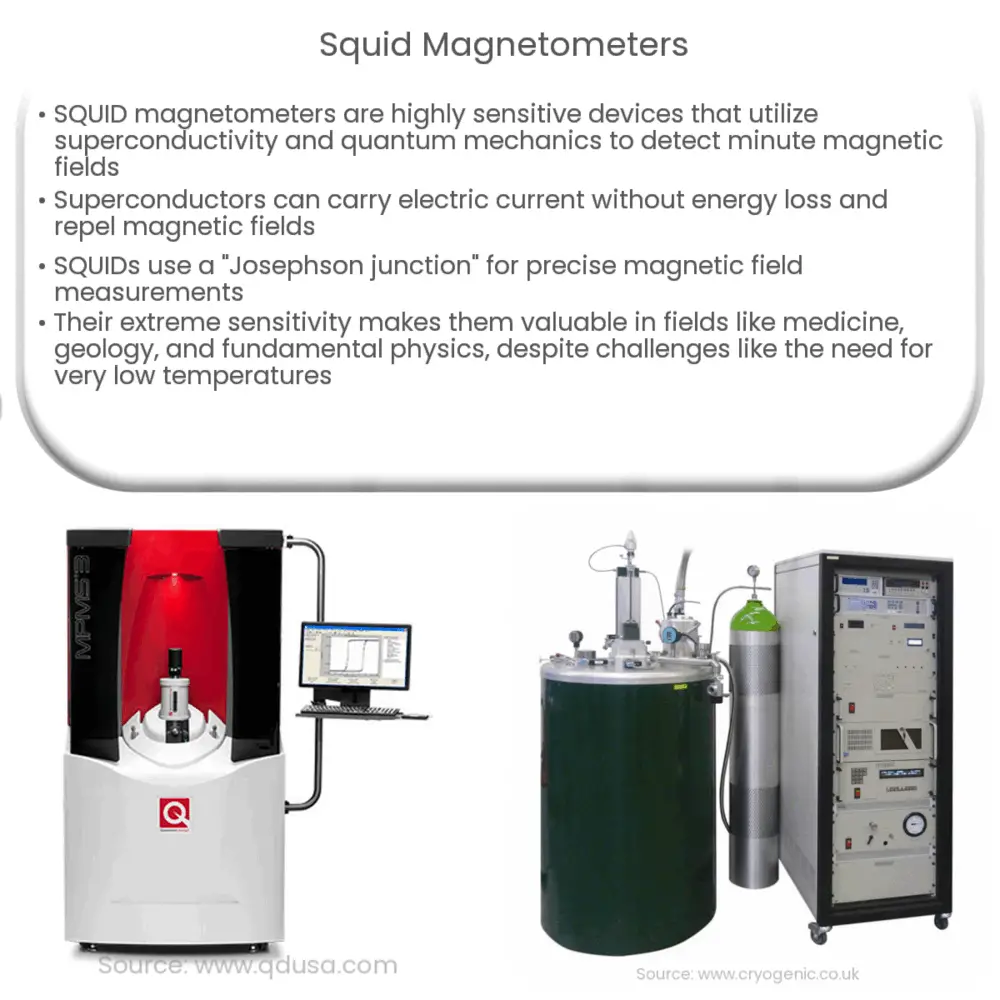Explore the workings of SQUID Magnetometers, their applications in various fields, and future advancements in this comprehensive article.

SQUID Magnetometers: The Power of Superconductivity in Precision Measurement
SQUID (Superconducting Quantum Interference Device) magnetometers are some of the most sensitive magnetic field detectors available. They capitalize on the unique properties of superconducting materials and quantum mechanics to detect even the smallest fluctuations in magnetic fields, down to the level of femtoteslas (10-15 teslas).
Understanding Superconductivity
Superconductivity is a quantum mechanical phenomenon that occurs when certain materials are cooled to extremely low temperatures, often near absolute zero. These materials, known as superconductors, exhibit perfect electrical conductivity, meaning that they can carry an electric current indefinitely without any energy loss. Moreover, superconductors expel magnetic fields, a phenomenon known as the Meissner effect.
The Mechanism of SQUID Magnetometers
SQUID magnetometers exploit these properties of superconductors to accurately measure magnetic fields. A SQUID consists of two superconducting layers separated by a thin insulating layer, forming a sandwich-like structure known as a “Josephson junction”. When a current is sent through this junction, it can “tunnel” through the insulator due to quantum mechanical effects, a process known as “Josephson tunneling”.
- The current flow results in a phase difference across the junction. This phase difference is sensitive to external magnetic fields, thus making it possible to measure these fields.
- The sensitivity of SQUIDs is so high that they can detect changes in magnetic fields corresponding to a change in magnetic flux of about one quantum, which is approximately 2.07 x 10-15 webers.
Applications of SQUID Magnetometers
The extreme sensitivity of SQUID magnetometers allows them to be used in a wide range of applications. They are employed in fields as diverse as medicine, geology, and fundamental physics research. For instance:
- In medicine, they are used in magnetoencephalography (MEG) to measure the tiny magnetic fields generated by neuronal activity in the brain.
- In geology, SQUID magnetometers can detect minute variations in the Earth’s magnetic field, aiding in the discovery of mineral deposits or the mapping of archaeological sites.
However, the use of SQUID magnetometers comes with challenges. Their operation requires extremely low temperatures, typically achieved using liquid helium, which can be costly and logistically complex. Furthermore, they are sensitive to noise and require careful shielding from external magnetic fields.
Advancements and Improvements in SQUID Magnetometers
Despite the challenges associated with their use, significant advancements have been made in the design and operation of SQUID magnetometers. For example, the development of high-temperature superconductors has reduced the necessity for extreme cooling, making the devices more practical for a wider range of applications.
Similarly, advancements in noise reduction and magnetic shielding technologies have made SQUIDs increasingly robust. This has expanded their use in environments previously thought to be too magnetically noisy for accurate measurements, such as in urban settings or near electrical equipment.
Future of SQUID Magnetometers
The future of SQUID magnetometers is bright. As our understanding of superconductivity and quantum mechanics continues to evolve, so too will our ability to harness these phenomena for increasingly sensitive and accurate magnetic field detection.
Emerging technologies, such as quantum computing and nanotechnology, may offer new ways to enhance the performance of SQUID magnetometers. For instance, the integration of SQUIDs with other quantum systems could lead to even more sensitive magnetic field detectors, while nanotechnology could enable the production of smaller, more cost-effective SQUIDs.
Conclusion
In conclusion, SQUID magnetometers represent a fascinating intersection of quantum mechanics, superconductivity, and precision measurement. Their exceptional sensitivity to magnetic fields has made them an invaluable tool in a range of fields, from medical imaging to geological exploration.
While they are not without their challenges, ongoing advancements in materials science, quantum mechanics, and nanotechnology hold the promise of even more effective and versatile SQUID magnetometers in the future. As such, these devices will continue to play a crucial role in our quest to measure and understand the subtle magnetic forces that permeate our world.

